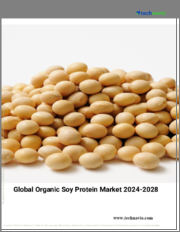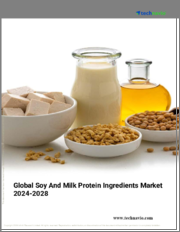
|
시장보고서
상품코드
1609898
일본의 대두 단백질 시장 보고서 : 형태, 최종 사용자 및 지역별(2024-2032년)Japan Soy Protein Market Report by Form (Concentrates, Hydrolyzed, Isolates), End User (Animal Feed, Personal Care and Cosmetics, Food and Beverage, Supplements), and Region 2024-2032 |
||||||
일본의 대두 단백질 시장 규모는 2023년 1억 7,300만 달러로 추정됩니다. 향후 IMARC Group은 2032년까지 시장 규모가 3억 7,400만 달러에 달하고, 2024년부터 2032년까지 6.10%의 연평균 성장률(CAGR)을 나타낼 것으로 예상하고 있습니다. 채식주의 새로운 트렌드와 영양가가 풍부한 식물성 단백질에 대한 선호도 증가가 시장 성장의 주요 원동력이 되고 있습니다.
본 보고서에서 다룬 주요 질문
- 일본의 대두 단백질 시장은 지금까지 어떻게 발전해왔고 앞으로 어떻게 발전할 것인가?
- 코로나19가 일본 대두 단백질 시장에 미치는 영향은?
- 일본 대두 단백질 시장의 형태별 구성비는?
- 일본 대두 단백질 시장의 최종 사용자별 분석은?
- 일본 대두 단백질 시장의 밸류체인에는 어떤 단계가 있는가?
- 일본 대두 단백질의 주요 촉진요인과 과제는?
- 일본 대두 단백질 시장의 구조와 주요 기업은?
- 일본 대두 단백질 시장에서의 경쟁은 어느 정도인가?
목차
제1장 서문
제2장 조사 범위와 조사 방법
- 조사 목적
- 이해관계자
- 데이터 소스
- 시장 추정
- 조사 방법
제3장 주요 요약
제4장 일본의 대두 단백질 시장 - 서론
- 개요
- 시장 역학
- 업계 동향
- 경쟁 정보
제5장 일본의 대두 단백질 시장 구도
- 과거 및 현재 시장 동향(2018년-2023년)
- 시장 예측(2024년-2032년)
제6장 일본의 대두 단백질 시장 - 형태별 분석
- 농축물
- 가수분해
- 분리주
제7장 일본의 대두 단백질 시장 - 최종사용자별 분석
- 동물사료
- 퍼스널케어 및 화장품
- 식품 및 음료
- 보충제
제8장 일본의 대두 단백질 시장 - 경쟁 구도
- 개요
- 시장 구조
- 시장 기업 포지셔닝
- 주요 성공 전략
- 경쟁 대시보드
- 기업 평가 상한
제9장 주요 기업 개요
제10장 일본의 대두 단백질 시장 - 업계 분석
- 성장 촉진요인 및 억제요인과 기회
- Porter의 Five Forces 분석
- 밸류체인 분석
제11장 부록
LSH 24.12.24Japan soy protein market size reached US$ 173 Million in 2023. Looking forward, IMARC Group expects the market to reach US$ 307.4 Million by 2032, exhibiting a growth rate (CAGR) of 6.10% during 2024-2032. The emerging trend of veganism, along with the rising preference for plant-based proteins with rich nutrient quotient, is primarily driving the market growth.
Soy protein, originating from soybeans, is recognized as a premium plant-based protein since it encompasses all vital amino acids needed for human health and development. Alongside this, it offers numerous health perks, including the reduction of cholesterol, betterment of cardiac health, and protection against osteoporosis. Being an economical option, soy protein often serves as a go-to replacement for proteins found in meat and dairy, especially in vegan and vegetarian meal plans. The product stands out due to its lean protein and low-fat composition, its lasting freshness, and its adaptability across diverse food processing methods. Owing to these attributes, it has become a staple in the culinary world, amplifying the nutritional value and consistency of an array of edibles, from nutrition bars and breakfast cereals to alternatives for traditional meat dishes.
Japan Soy Protein Market Trends:
The Japan soy protein market is witnessing a surge due to consumers increasingly opting for plant-based proteins over those derived from animals. This shift is further amplified by the rising trend of veganism, heightened health concerns, and growing understanding of the health merits of soy protein. Moreover, athletes and fitness enthusiasts are particularly inclined towards soy protein, due to its minimal sugar and rich nutrient content. Its versatility is evident as it finds its way into baked goods and confectioneries, enhancing their taste, structure, and longevity. Notably, its inclusion in baby nutrition and its acceptance in animal nutrition highlight its broad appeal. Cutting-edge developments in the culinary sector, facilitating the introduction of superior plant-based meat substitutes, along with significant R&D commitments by industry leaders, are further catalyzing the Japan market. In addition to this, the expanding food and drink sector, consumers' rising spending power, and the ease of procuring products from a diverse range of physical and online stores will continue to drive the Japan soy protein market in the coming years.
Japan Soy Protein Market Segmentation:
Form Insights:
- Concentrates
- Hydrolyzed
- Isolates
End User Insights:
- Animal Feed
- Personal Care and Cosmetics
- Food and Beverages
- Bakery
- Beverages
- Breakfast Cereals
- Condiments/Sauces
- Dairy and Dairy Alternative Products
- RTE/RTC Food Products
- Snacks
- Supplements
- Baby Food and Infant Formula
- Elderly Nutrition and Medical Nutrition
- Sport/Performance Nutrition
Competitive Landscape:
The market research report has also provided a comprehensive analysis of the competitive landscape in the market. Competitive analysis such as market structure, key player positioning, top winning strategies, competitive dashboard, and company evaluation quadrant has been covered in the report. Also, detailed profiles of all major companies have been provided.
Key Questions Answered in This Report:
- How has the Japan soy protein market performed so far and how will it perform in the coming years?
- What has been the impact of COVID-19 on the Japan soy protein market?
- What is the breakup of the Japan soy protein market on the basis of form?
- What is the breakup of the Japan soy protein market on the basis of end user?
- What are the various stages in the value chain of the Japan soy protein market?
- What are the key driving factors and challenges in the Japan soy protein?
- What is the structure of the Japan soy protein market and who are the key players?
- What is the degree of competition in the Japan soy protein market?
Table of Contents
1 Preface
2 Scope and Methodology
- 2.1 Objectives of the Study
- 2.2 Stakeholders
- 2.3 Data Sources
- 2.3.1 Primary Sources
- 2.3.2 Secondary Sources
- 2.4 Market Estimation
- 2.4.1 Bottom-Up Approach
- 2.4.2 Top-Down Approach
- 2.5 Forecasting Methodology
3 Executive Summary
4 Japan Soy Protein Market - Introduction
- 4.1 Overview
- 4.2 Market Dynamics
- 4.3 Industry Trends
- 4.4 Competitive Intelligence
5 Japan Soy Protein Market Landscape
- 5.1 Historical and Current Market Trends (2018-2023)
- 5.2 Market Forecast (2024-2032)
6 Japan Soy Protein Market - Breakup by Form
- 6.1 Concentrates
- 6.1.1 Overview
- 6.1.2 Historical and Current Market Trends (2018-2023)
- 6.1.3 Market Forecast (2024-2032)
- 6.2 Hydrolyzed
- 6.2.1 Overview
- 6.2.2 Historical and Current Market Trends (2018-2023)
- 6.2.3 Market Forecast (2024-2032)
- 6.3 Isolates
- 6.3.1 Overview
- 6.3.2 Historical and Current Market Trends (2018-2023)
- 6.3.3 Market Forecast (2024-2032)
7 Japan Soy Protein Market - Breakup by End User
- 7.1 Animal Feed
- 7.1.1 Overview
- 7.1.2 Historical and Current Market Trends (2018-2023)
- 7.1.3 Market Forecast (2024-2032)
- 7.2 Personal Care and Cosmetics
- 7.2.1 Overview
- 7.2.2 Historical and Current Market Trends (2018-2023)
- 7.2.3 Market Forecast (2024-2032)
- 7.3 Food and Beverages
- 7.3.1 Overview
- 7.3.2 Historical and Current Market Trends (2018-2023)
- 7.3.3 Market Segmentation
- 7.3.3.1 Bakery
- 7.3.3.2 Beverages
- 7.3.3.3 Breakfast Cereals
- 7.3.3.4 Condiments/Sauces
- 7.3.3.5 Dairy and Dairy Alternative Products
- 7.3.3.6 RTE/RTC Food Products
- 7.3.3.7 Snacks
- 7.3.4 Market Forecast (2024-2032)
- 7.4 Supplements
- 7.4.1 Overview
- 7.4.2 Historical and Current Market Trends (2018-2023)
- 7.4.3 Market Segmentation
- 7.4.3.1 Baby Food and Infant Formula
- 7.4.3.2 Elderly Nutrition and Medical Nutrition
- 7.4.3.3 Sport/Performance Nutrition
- 7.4.4 Market Forecast (2024-2032)
8 Japan Soy Protein Market - Competitive Landscape
- 8.1 Overview
- 8.2 Market Structure
- 8.3 Market Player Positioning
- 8.4 Top Winning Strategies
- 8.5 Competitive Dashboard
- 8.6 Company Evaluation Quadrant
9 Profiles of Key Players
- 9.1 Company A
- 9.1.1 Business Overview
- 9.1.2 Product Portfolio
- 9.1.3 Business Strategies
- 9.1.4 SWOT Analysis
- 9.1.5 Major News and Events
- 9.2 Company B
- 9.2.1 Business Overview
- 9.2.2 Product Portfolio
- 9.2.3 Business Strategies
- 9.2.4 SWOT Analysis
- 9.2.5 Major News and Events
- 9.3 Company C
- 9.3.1 Business Overview
- 9.3.2 Product Portfolio
- 9.3.3 Business Strategies
- 9.3.4 SWOT Analysis
- 9.3.5 Major News and Events
- 9.4 Company D
- 9.4.1 Business Overview
- 9.4.2 Product Portfolio
- 9.4.3 Business Strategies
- 9.4.4 SWOT Analysis
- 9.4.5 Major News and Events
- 9.5 Company E
- 9.5.1 Business Overview
- 9.5.2 Product Portfolio
- 9.5.3 Business Strategies
- 9.5.4 SWOT Analysis
- 9.5.5 Major News and Events
10 Japan Soy Protein Market - Industry Analysis
- 10.1 Drivers, Restraints, and Opportunities
- 10.1.1 Overview
- 10.1.2 Drivers
- 10.1.3 Restraints
- 10.1.4 Opportunities
- 10.2 Porters Five Forces Analysis
- 10.2.1 Overview
- 10.2.2 Bargaining Power of Buyers
- 10.2.3 Bargaining Power of Suppliers
- 10.2.4 Degree of Competition
- 10.2.5 Threat of New Entrants
- 10.2.6 Threat of Substitutes
- 10.3 Value Chain Analysis

















